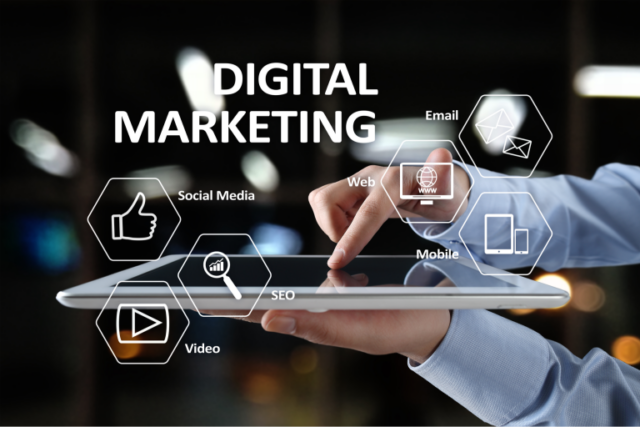If you think that communication plays a significant role in a business’s success, you are right. Effective communication enables the business to convey its message to the audience, helps it achieve its business goals, and builds relationships. That is where strategic content comes into play. It ensures that your communication efforts are well-organized, impactful, and laser targeted.
In a digitally connected world, the landscape of communication is constantly changing. That is why having a strategic content plan is a must. However, creating a content plan is not that easy if you don’t have the right skills, knowledge, and expertise. That is why if you want to make your organization’s communication more effective, you will benefit from having a master’s degree in communication. St. Bonaventure University offers the master in communication online, a virtual degree that is ACEJMC-accredited, and students can complete it in just 22 months. This program is designed to help you acquire the right knowledge and skills to develop high-performing content, analyze data, measure the success of your content, and craft a content strategy that works to your business’s advantage and helps it accomplish its business goals.
Armed with this degree and the knowledge it equips you with, you will be able to adopt a proactive approach to content planning. It will help you enhance your ability to engage with your audience, strengthen your brand’s position, and drive the desired action from your readers.
Why your business needs strategic content planning

Some businesses do not have a content plan in place. They post ad hoc messages on their social media or blog and then wonder why there is no audience engagement. On the other hand, when businesses use strategic content planning, they can tailor their messages to different audience segments. It is prudent to remember that different groups of people have unique needs, communication styles, and preferences.
When you understand your target audience, you can create messages that resonate with them. That, in turn, increases the chances of capturing their attention, generating interest, and fostering meaningful relationships.
Here are some tips on understanding your audience so that you can gather the right information and get an in-depth understanding of what they want and how they prefer to engage.
Surveys: Usually, surveys are used to collect quantitative data about the audience. They help you better understand your audience’s preferences, habits, and demographics. You can use email, social media platforms, or website pop-ups to distribute surveys to existing and prospective customers.
Interviews: When you conduct interviews, you get an opportunity to delve deeper into your audience’s thoughts, opinions, and experiences. These qualitative insights can help you uncover valuable details that quantitative data might not reveal.
Focus groups: Organizing focus groups allows you to gather a small group of individuals representing your target audience. Through facilitated discussions, you can obtain feedback, ideas, and perceptions about your brand, products, or services.
Social media listening: If you monitor social media platforms and relevant forums, it can provide valuable insights into conversations, sentiments, and trends related to your industry or niche. This helps you understand your audience’s interests, pain points, and engagement preferences.
Goal setting for your communication efforts

Setting clear goals is essential for any communication strategy. Without specific objectives, your content may lack direction and fail to deliver meaningful results. Here are some key reasons why setting clear goals is crucial:
Focus and alignment: Having clear goals provides focus and helps support your communication efforts. Whether it’s increasing brand awareness, driving website traffic, generating leads, or enhancing customer engagement, well-defined goals guide your content planning and execution.
Measurement and evaluation: When the goals are clear, you can measure and evaluate the effectiveness of your communication efforts. By setting specific metrics and key performance indicators (KPIs), you can track your progress, identify areas for improvement, and make data-driven decisions to optimize your content strategy.
Accountability and resource allocation: This enables your team to understand their responsibilities better. This leads to proper resource allocation and ensures that everyone is working towards a common objective. It improves efficiency and enhances the likelihood of achieving desired outcomes.
When setting goals, make sure they are specific, measurable, achievable, relevant, and time-bound (SMART). For example, instead of a general goal like increasing brand awareness, a SMART goal would be to increase website traffic by 20% through organic search within six months.
Identifying key messaging aligned with your objectives
Key messages are the core ideas or themes you want to convey through your communication efforts. They are the key takeaways you want your audience to remember and associate with your brand. Here’s why you need to identify key messages:
Consistency and clarity: This ensures consistency and clarity in your communication. It helps your content convey a cohesive narrative and reinforce your brand’s positioning. By consistently delivering key messages across various channels, you establish a strong brand identity and improve message retention.
Audience relevance: Remember that when you create your key messages, they should resonate with your target audience. By understanding their needs, pain points, and motivations, you can customize your messages to address their specific concerns and provide solutions that align with their interests.
Differentiation: The way you craft your messages allows you to stand out amid your competition. Each message highlights your unique value proposition and what sets you apart in the market. By articulating the unique benefits and advantages of your products, services, or solutions, you can position your brand as the preferred choice.
Crafting a compelling value proposition

A value proposition is a concise and precise statement that communicates the unique value your brand offers customers. It summarizes the benefits and advantages customers can expect by choosing your products or services over other alternatives on the market. Here are a few reasons why you should focus on creating a persuasive value proposition:
Competitive advantage: A strong value proposition sets you apart from competitors by clearly articulating the unique value you provide. It offers a reason to your target audience why they should choose your brand over others. A gripping value proposition helps you stand out in a crowded market and attract your target audience.
Customer-centric focus: A well-crafted value proposition emphasizes the benefits and outcomes that customers care about. It addresses their pain points and desires and demonstrates how your brand can meet their needs and solve their problems. Such a value proposition allows you to create an emotional connection with your audience.
Communication guidance: This serves as a guide for crafting key messages and content. It helps you communicate consistently and effectively across different channels, ensuring your messaging aligns with your brand’s unique value proposition.
Conducting a content audit

Before you begin strategic content planning, you must audit your existing content across all channels to assess its quality, performance, and relevance. Auditing provides valuable insights into what content you currently have, how it is performing, and where there are opportunities for improvement. It gives you a roadmap for your content strategy and ensures you always deliver value to your existing and prospective customers. Here are some of the main steps involved in content auditing:
Assessing your existing content: The first step in a content audit is to evaluate your existing content assets. This involves compiling a comprehensive inventory of all the content pieces you have created, including blog posts, articles, videos, infographics, whitepapers, and social media posts. Here is how you can assess your content assets:
Evaluating performance metrics of the content: The next step is to evaluate the performance of your content using relevant metrics. You can use Google Analytics, SEO performance, social media metrics, and conversion metrics for this purpose. This gives insights into how your content resonates with your audience, driving engagement and contributing to your goals.
Identifying gaps and opportunities for improvement: The final step in content auditing is identifying any gaps in your content and areas for improvement. Focus on things like content quality, relevance to your target audience’s needs and interests, content format, distribution channels, and high-performing content that you can repurpose.
Content ideation and brainstorming
When you brainstorm and come up with content ideas, it ensures your business has a consistent flow of creative content that keeps your audience engaged. You can use brainstorming techniques such as mind mapping, random word association, SCAMPER technique, and reverse brainstorming to develop creative ideas for content creation.
Make sure that you also create a content calendar that allows you to plan and organize content creation and publishing schedules. It will give you a structured framework to manage the entire content creation process and ensure you have a smooth and consistent stream of content for different channels.
The content you create will depend on your target audience. So, go back to audience research and buyer personas to ensure relevance. Also, stay updated on industry trends, news, and developments. Use these insights as inspiration for content ideas that are timely and relevant to your audience. Often, you can repurpose optimally performing content for different channels. For instance, you can convert a well-received blog post into a video, podcast, or infographic.
Content and buyer’s journey

The buyer’s journey represents the stages a potential customer goes through, from awareness to consideration to decision-making. Aligning your content with the buyer’s journey ensures that you provide relevant and valuable information at each stage, nurturing leads and guiding them toward making a purchase. It allows your brand to establish trust and position itself as a reliable solution. Here’s how you can align your content with the buyer’s journey:
Awareness stage: Create content that helps your audience identify and understand their challenges or needs. Focus on educational content, blog posts, social media posts, and videos that address common pain points and provide solutions.
Consideration stage: Provide content that showcases your expertise, products, or services. Offer in-depth guides, case studies, webinars, or comparison articles to help your audience evaluate options and make informed decisions.
Decision stage: Offer content that helps your audience make a final purchasing decision. This can include product demonstrations, testimonials, free trials, pricing information, and personalized consultations.
Developing a content distribution plan

Such a plan outlines how and where you will distribute your content to reach your target audience effectively. By developing a well-defined content distribution plan, you can maximize the visibility and reach of your content, ensuring it reaches the right audience through the most effective channels. Here are the key steps to developing a distribution plan:
Identify relevant channels: Determine the channels where your target audience is most active. This can include your website, blog, social media platforms, email newsletters, industry publications, or third-party platforms.
Customize content for each channel: Adapt your content to fit the format and requirements of each distribution channel. For example, create shorter snippets for social media, optimize content for SEO on your website, or customize content for specific email segments.
Consistency and frequency: Establish a consistent publishing schedule for each channel to maintain a regular presence. This helps keep your audience engaged and builds anticipation for new content.
Amplify reach through strategic partnerships: Explore opportunities for partnerships or collaborations with influencers, industry experts, or complementary brands. It works to expand your content’s reach and expose your brand to new audiences.
Measurement and optimization: Track the performance of your content distribution efforts using analytics tools. Evaluate engagement metrics, traffic sources, and conversion rates to identify successful channels and make data-driven optimizations.
Incorporating different content formats

Having a range of different content formats adds variety to your content strategy and caters to diverse audience preferences. Various content formats allow you to cater to different learning styles, preferences, and consumption habits. It adds depth and variety to your content strategy, making it more engaging and impactful. Here are some popular content formats to consider:
Blog posts and articles: These content forms remain the mainstay of content marketing. They allow you to explore different topics in-depth, support your SEO efforts, and provide educational value to your audience.
Videos: Over the years, video has gained immense popularity. It offers a dynamic and engaging way to communicate your message, demonstrate products, share tutorials, or interview industry experts. Videos can be shared on your website, social media channels, or video-sharing platforms like YouTube, where you can create a dedicated channel to reach your target audience.
Infographics: This content combines visuals and concise text to present complex information in an easily digestible format. They are visually appealing, shareable, and effective for presenting data, statistics, or step-by-step processes.
Podcasts: Podcasts allow you to deliver audio content on various topics. They are convenient for on-the-go consumption and enable you to connect with your audience through interviews, discussions, or storytelling.
eBooks and guides: If you want to provide long and in-depth information on specific topics, choose to publish eBooks and guides. They serve as valuable resources that can be downloaded or accessed in exchange for contact information, thereby supporting your lead-generation efforts.
Interactive content: Content, such as quizzes, assessments, surveys, or interactive infographics, encourages your target audience to engage with your content. It provides an interactive experience, boosts participation, and helps gather valuable data.
SEO and keyword research

Search engine optimization (SEO) plays a crucial role in driving organic traffic to your website and increasing your online visibility. It is an integral part of content strategy and should never be ignored. By understanding the basics of SEO, you can optimize your content to rank higher in search engine results.
SEO encompasses various strategies and techniques aimed at improving your website’s visibility in search engine results pages (SERPs). Here are some main aspects to consider:
On-page optimization: This involves optimizing individual web pages to improve search engine rankings. It includes optimizing meta tags, URL structure, and headings like H1 and H2 and adding relevant keywords naturally within the content.
Off-page optimization: This refers to activities conducted outside your website to improve its online reputation and authority. This includes building high-quality backlinks from reputable sources, social media engagement, and online brand mentions.
Site structure and navigation: Creating a clear and user-friendly website structure helps search engines understand your content better. Organize your content into logical categories and use internal linking to establish connections between related pages.
Responsive content: With the majority using mobile devices to find services and products, optimizing your website for mobile responsiveness and usability is essential. Ensure your site is mobile-friendly and provides a seamless user experience across different devices.
Conclusion

Your strategic content plan should have a way to measure and analyze the performance of the content you have created. This enables you to understand the effectiveness of your digital marketing strategy and allows you to make data-driven decisions to optimize your efforts. Effective content planning is an ongoing process and does not stop after a single attempt. That is why you need to continuously monitor and evaluate your content strategy, stay informed about industry trends, and be open to experimenting with new approaches. When you become proactive and have a strategic content plan, it enables you to create impactful content that your audience can identify with, helps you engage with them, and drives meaningful results for your business.









